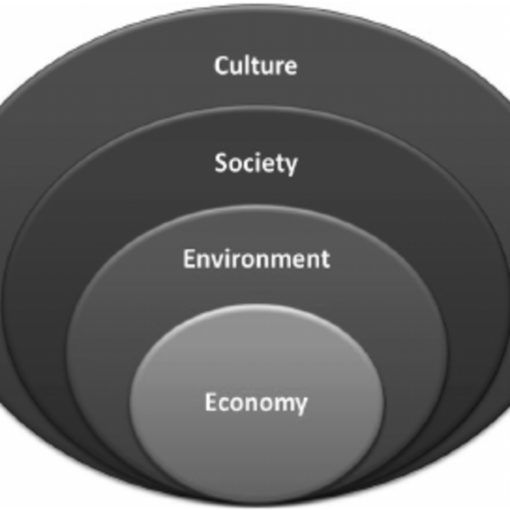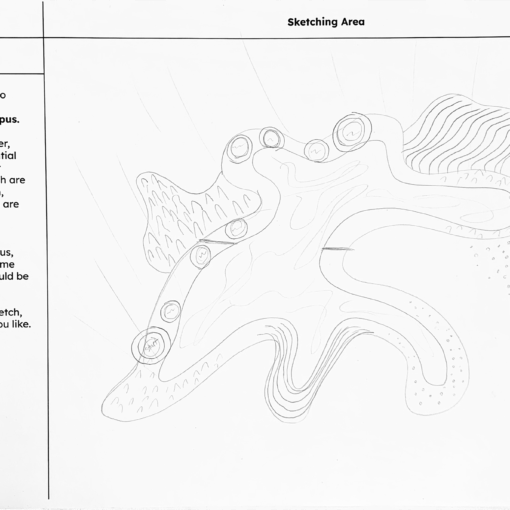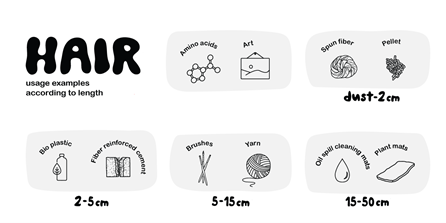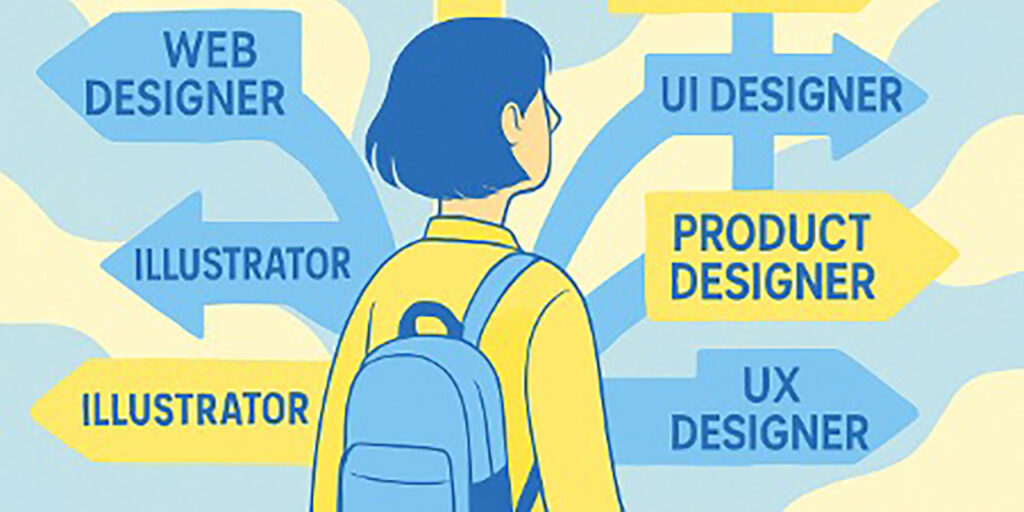
This article explores the state of the design job market in Finland during the first quarter of 2025. The goal is to support students at LAB University of Applied Sciences – as well as other design students and working professionals in Finland – in understanding the types of roles currently available, the skills employers are seeking, and how the evolving nature of design work is reflected in real-world hiring practices.
Design is changing
Recent research in the design field shows that design is changing (e.g. Dziobczenski, 2021; Valtonen, 2020). For example, designers are working in more projects under the label of ‘strategic design’ (see Calabretta, Gemser, 2017; Dziobczenski, 2024). In short, this means that designers expand their work to not only design websites, products or services, but also apply their skill sets to design strategies.
The Steinberg funnel below represents this change when designers work in a strategic level: In traditional design projects, decisions are often limited to specific elements like colours and fonts, whereas in strategic design projects, decisions are broader and more impactful.
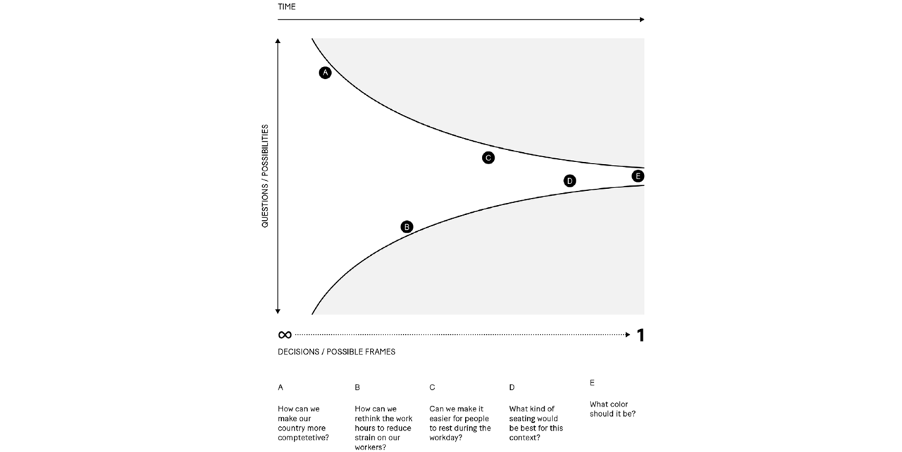
This change is evident in the job market: new job titles are emerging (Hello AI Designer), companies are requesting different skill sets during interviews, and job ads reflect expanded responsibilities for designers.
The Design Job Market in Finland
Data from 2023 and 2024 reveal a downward trend in the design job market according to the positions posted on the Designcareer, a job board for designers in Finland (link to the Designcareer website). The website groups positions posted in both English and Finnish across multiple career websites, such as LinkedIn, Duunitori and Oikotie.
There were 190 positions in 2023 (about 16/month), falling to 108 positions in 2024 (around 9/month). In the first quarter of 2025, signs of recovery are visible: 35 positions have been posted so far (approximately 11/month). While this is an improvement over 2024, it still falls short of 2023 levels.
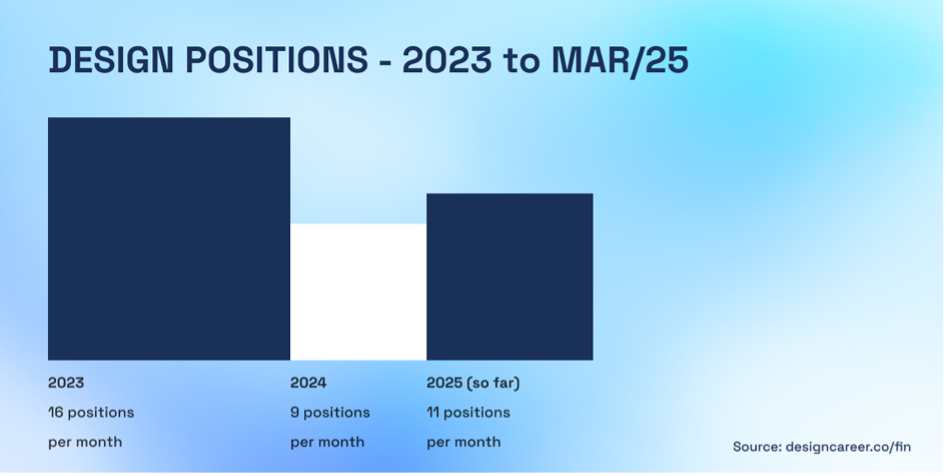
Almost 3 out of 4 positions were in-house (26 out of 35), while agencies had 9 positions. This shows a preference among employers to grow their internal design capabilities and build a in-house design team. The majority of mid-level roles account for 57% of positions (20 out of 35). Senior roles made up 31% (11 out of 35) and junior roles were just 11% (4 out of 35).
Product design is the most frequent job title in the sample, with Product Designer roles accounting for 8 of the 35 positions (approximately 23%). Below is the full breakdown:
- Product Designer: 8 positions (≈23%)
- UX Designer: 6 positions (≈17%)
- Visual Designer (UI Designer, Graphic Designer, Visual Designer): 5 positions (≈14%)
- Service Designer: 3 positions (≈9%)
- AI Designer: 2 positions (≈6%)
- Industrial Designer: 2 positions (≈6%)
- UX/UI Designer: 2 positions (≈6%)
- Others (Designer, Motion Designer, etc.): 7 positions (≈20%)
Final thoughts
- Tight Competition for Junior Roles: On average, only 1 in every 10 positions is for junior designers. This reflects the tight competition for entry-level roles
- New technologies shaping the work of designers: For example, ‘AI Designer’ positions are starting to pop up, signaling a change in tools for designers in their working.
- Market Recovery & Maturity: Early 2025 shows signs of recovery with a dominance of in-house positions and a preference for mid-to-senior roles, reflecting a growing maturity in how companies value and structure their design capabilities.
The analysis of job titles reveals that Product Designer roles were the most frequent during the first quarter of 2025 – 23% of positions. Other categories such as UX Designer, Visual Designer, and Service Designer also were present. These findings illustrate a diverse and evolving job market that reflects in what kind of titles designers are being employed.
Author
Paulo Roberto Nicoletti Dziobczenski, Chief Specialist in Strategic Design Innovations at LAB University of Applied Sciences and member of the Design for Futures research group. His work focuses on how strategic design can help organizations foster sustainable growth.
References
Boyer, B. 2020. Helsinki design lab ten years later. She Ji: The Journal of Design, Economics, and Innovation. Vol. 6 (3), 279–300.
Calabretta, G. & Gemser, G. 2017. Building blocks for effective strategic design. Journal of Design, Business & Society. Vol. 3 (2), 109–124.
Dziobczenski, P.R.N. 2021. Graphic designers’ work and skillset – what companies talk about in their job advertisements. Doctoral dissertation. Department of Design. Aalto University.
Dziobczenski, P.R.N. 2024. Strategic Design for Green Transition: Expanding Designers’ Responsibilities and Impact. What’s Around Design? 2024 International Conference. Portimão, Portugal. Cited 1 Apr 2025. Available at https://www.researchgate.net/publication/384894816_Strategic_Design_for_Green_Transition_Expanding_Designers’_Responsibilities_and_Impact
Valtonen, A. 2020. Approaching Change with and in Design. She Ji. Vol. 6 (4), 505–529.
Links
Link 1. Designcareer.co/fin Website. Cited 3 Apr 2025. Available at https://www.designcareer.co/fin

